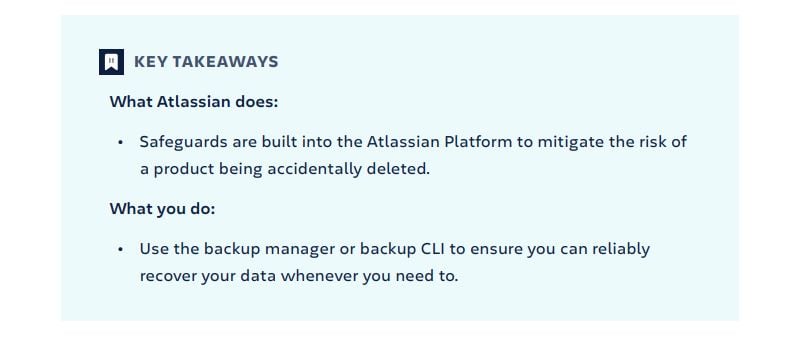How to Backup Jira | Jira Cloud | Revyz.io
A comprehensive guide to backing up Jira Cloud including 3 different methods, best practices and step by step instructions.
Table of Contents
- The Importance of Jira Backups
- The Reasons to Backup Jira Data
- Atlassian Cloud Data Protection Limitations
- Emerging Threats for Atlassian Cloud Customers
- How to Backup Jira Cloud (3 Methods)
- Best Practices for Jira Backups
- Advanced Backup Strategies
The Importance of Data Backups
In the world of project management, Jira stands as a reliable platform, empowering teams to collaborate effectively and drive projects to success. However, to maintain this reliability, businesses must implement a robust Jira cloud backup strategy to safeguard valuable project data. Yet, even the most reliable systems are not immune to data loss or corruption. That's why having a robust backup strategy in place is essential to ensure your projects and the safety of your data stay uninterrupted.
“Backup before you do anything. It's so, so important"
Jira Cloud Expert - Jan Szczepanski When interviewed about best practice in Jira Cloud change management
Jira serves as a giant container of project management and support, with the ability to organize data in a jira hierarchy view, making it easier to manage and back up complex relationships between projects, issues, and tasks. Any loss or corruption of this data can spell disaster for project timelines, team collaboration, service delivery agreements and the sanity of your team
Therefore, implementing a robust backup strategy is paramount to safeguarding your organization's valuable assets and ensuring that when the inevitable day comes that your data has been impacted - you are 100% confident in your ability to get it back quickly.
The Reasons to Backup Jira Cloud
Like any business software platform, the need to back up Jira is no different and are generally categorized below;
- Cloud Limitations: Although the Jira Cloud platform does automatically provide backups of the platform - this backup is not available for customers to restore for their own purposes, such as when data is lost, damaged or deleted.
- Security: Protecting sensitive project information from unauthorizeity threats is even more important when integrating automated Jira XML backup solutions that ensure consistent protection across your Jira environments.
- Compliance: Meeting regulatory requirements and industry standards regarding data retention and protection.
- Disaster Recovery: Minimizing downtime and data loss in the event of system failures, natural disasters, or cyber-attack.
- Business Continuity: Ensuring uninterrupted operations and seamless project execution, even in the face of unforeseen challenges or disruptions.
Atlassian Cloud Data Protection Limitations
Like most large cloud application providers, Atlassian provides a basic level of data protection but requires customers to take responsibility of how they manage their data protection strategies - in plain English, this means that you need to take the lead on your data backups and make sure that you have a setup that meets your business recovery needs.
The image below is from the Atlassian Cloud Data Protection Guide
2024 and Beyond - the Emerging Threat Landscape for Atlassian Customers
Although the historical needs to back up your data are still very valid, some threats are on the rise in terms of both frequency and complexity. In December 2023, we got the chance to interview two global experts in cyber-security from Splunk and Mandiant.
You can view this recording below.
|
The 2024 Cyber Security Threat Landscape Webinar Topics
|
|
How to Backup Jira Cloud? (3 Methods)
So now that we’ve established what data you have in your Jira Cloud, how important it is and the ways that you could lose it - how can you protect it with data backups?
We’ve listed below really the only three options available right now to backup your Jira Data;
Option 1 : Use the native tools in Jira Cloud to Back Up
Jira offers built-in tools and features for creating backups, making the process straightforward and accessible to users of all levels. By navigating to the System settings and selecting the Backup Manager, users can initiate full or partial backups of their Jira Cloud instance. These backups encompass essential components such as issues, attachments, configurations, and user preferences, providing comprehensive data protection and recovery capabilities.
Jira auto backup options are limited in Jira Cloud. Currently, you can perform data-only backups (which exclude attachments, avatars, and logos) at any time. When you create a backup that includes attachments, avatars, and logos, you will need to wait 48 hours from the last time you created a backup with attachments.
Source: Jira Software Support
To create a backup for cloud:
Select Settings (⚙️) > System
In the IMPORT AND EXPORT section, select Backup manager.
Under Backup for cloud, select Create backup for cloud.
You can tick the Include additional files option if you want to include issue attachments, user avatars, and project logos in the export.
After the backup is complete, select Download backup file.
You can only do this manual process every two days, this is an inbuilt limitation inside Jira Cloud. Therefore, each time that you run your backup, it will replace the previous backup data so you must be careful about managing your backups and export files.
Option 2 : Create and schedule scripts to back up your Jira Cloud data
A practically superior option to using the native backup tool in Jira is to create a script that backs up your data by manually exporting it and then having that script run on a scheduler. However, it is critical to remember that this method still requires comprehensive Jira disaster recovery measures to ensure backup reliability.
This will allow you to run your backups more frequently and will also allow you to do things like keep multiple copies of your backup data allowing a longer time period between the identification of data damage to the moment of data restore.
Challenges
This option definitely provides some more assurance, but it it does come loaded with some hidden risks, such as;- Batch scripts can be executed, but are notoriously not fault tolerant, so if your script runs into problems - you may never notice that your backup files are corrupt, or even non-existent without manual checks each backup cycle to confirm and sanity check backup file integrity
Restoring individual files, tickets, or projects from a script generated backup is no fun - the restore itself is really just an import of the data but it is a very manual process and will tie up your valuable time. - While manual backups are effective, they can be time-consuming and prone to human error. That's where automation comes in. By leveraging third-party tools, scripts, and plugins, teams can streamline the backup process, reduce manual intervention, and ensure consistent backups at regular intervals.
"Atlassian fails HARD on this requirement (automation). There is no automatic way to set up this backup. I mean, there is a Github repo for a python script that scrapes the site for the backup, but even that is one change away from being useless.."
Rodney Nissen
TheJiraGuy.com
Option 3 : Use a marketplace app to backup Jira Cloud
Solutions like jira use cases Revyz Data Manager for Jira offer a seamless solution for automating Jira backup processes, making it suitable for a variety of Jira use cases, including project management, software development, and IT operations.
By leveraging Revyz's intuitive interface and advanced features, teams can streamline backup operations, ensure data currency, and minimize human errors. With third-party tools like Revyz, automating Jira backup is as simple as a few clicks, freeing up valuable time and resources for strategic initiatives.
When evaluating Marketplace Apps for Jira Backups, make sure that your select a solution that is compliant to your data residency, is Cloud Fortified and has aligned with your organizational compliance policies with reputable third-party compliance protocols such as SOC2.
Best Practices for Jira Backups
- Regularity: Establish a consistent Jira backup project schedule to ensure data currency and minimize the risk of data loss, whether it’s daily, weekly, or monthly. Regular Jira cloud backup processes are vital for a comprehensive disaster recovery plan.
- Automation: Relying on manual procedures to perform backups on your schedule is neither efficient or reliable. Its highly recommended that you automate your backup processes in a way that is both reliable and visible to your Jira Administrators.
- Redundancy: Maintain multiple copies of backups in secure locations, both on-premises and in the cloud, to guard against hardware failures, data corruption, and other unforeseen events.
- Verification: Periodically validate backup integrity and restoration procedures to ensure they are functioning as intended. Conducting test restores and verifying data consistency are essential steps in maintaining a reliable backup strategy.
- Documentation: Document backup procedures, schedules, and contingency plans in detail, ensuring that all team members are aware of their roles and responsibilities in the event of a data loss incident.
Advanced Backup Strategies
- Customized Backups: Tailor backup procedures to include specific components or project elements based on organizational requirements and priorities. Whether it's backing up specific projects, issue types, or custom fields, customization allows teams to focus on what matters most.
- Incremental Backups: Implement incremental backup techniques to capture only the changes made since the last backup, reducing storage requirements and backup duration. By identifying and backing up only the delta changes, teams can optimize backup efficiency and minimize resource consumption.
- Disaster Recovery Planning: Develop comprehensive disaster recovery plans outlining procedures for restoring Jira data in the event of catastrophic incidents such as server failures, data breaches, or natural disasters. Establishing clear protocols, roles, and communication channels is crucial for executing timely and effective recovery operations.
- Security: Your data backups contain sensitive information and are a highly prized target of cyber-criminals. For organizations seeking to protect their Jira environments, integrating HIPAA backup compliance into your backup strategy ensures your data meets strict regulatory standards. Utilize backup strategies and solutions ensure that your data is protected by encryption, stored independently from your primary data location and accessible only to authorized personnel in your organization
- Data Sovereignty: When you take a copy of your primary Jira data and store it as a backup file, you need to make sure that this storage location is aligned with your organization's data residency rules.
Conclusion
The stakes have never been higher when it comes to protecting your data. With atlassian jira backup solutions, you can safeguard your Jira environment and confidently handle unforeseen issues, ensuring business continuity and operational resilience. By mastering the art of Jira backup and adopting a proactive approach to data protection, organizations can mitigate risks, safeguard their valuable assets, and maintain operational resilience in the face of adversity. Whether you're a small startup, a large enterprise, or somewhere in between, investing in a comprehensive backup strategy is essential for safeguarding your organization's success and agility.
Videos on How to Backup Jira Cloud
Watch the following informative videos on how to back up, restore and protect the data and configuration of your Jira Cloud
Watch Alex Ortiz demonstrate how to use the Revyz granular restore feature to restore individual Jira tickets
Join Alex Ortiz for an informative demonstration on how to restore Jira Automations that can easily be damaged or lost
How do you plan disaster recovery in Jira Cloud? Watch as Alex Ortiz walks you through this step by step



